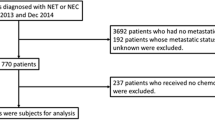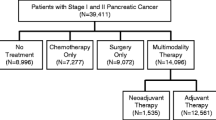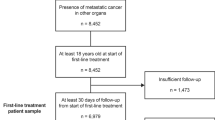Abstract
Pancreatic neuroendocrine tumors (pNETs) are rare, slow-growing cancers. Optimal treatment of advanced pNETs is unclear. The aim of this study was to examine treatment patterns and preferences among an academic tertiary medical center and community-based oncology practices. Retrospective chart review was performed for patients with newly diagnosed locally advanced, metastatic, or unresectable pNET diagnosed between January 2010 and December 2013 at an academic tertiary cancer center [University of California, San Francisco (UCSF)] or a large network of community oncology practices [Altos Solutions’ OncoEMR database (ALTOS)]. Fifty-four eligible patients (N UCSF = 23; N ALTOS = 31) were identified. Median time to treatment initiation was 1.1 months; median follow-up time was 22.9 months. UCSF patients underwent more lines of therapy than ALTOS patients despite similar follow-up times. UCSF tended toward more invasive treatment than ALTOS. The median time to treatment discontinuation was statistically significantly shorter for patients on chemotherapy than on targeted therapy in the combined UCSF and ALTOS groups (chemotherapy = 2.1 months vs. targeted = 18.6 months, p < 0.001). Treatment patterns and duration for newly diagnosed advanced pNETs vary widely both within and between different practice settings. Further studies are warranted to investigate the significant difference in duration of targeted therapy compared to chemotherapy.



Similar content being viewed by others
References
Capozzi M, Caterina I, De Divitis C, et al. Everolimus and pancreatic neuroendocrine tumors (PNETs): activity, resistance and how to overcome it. Int J Surg. 2005;21(Suppl 1):S89–94.
Cloyd JM, Poultsides GA. Non-functional neuroendocrine tumors of the pancreas: advances in diagnosis and management. World J Gastroenterol. 2015;21(32):9512–25.
Martin-Perez E, Capdevila J, Castellano D, et al. Prognostic factors and long-term outcome of pancreatic neuroendocrine neoplasms: Ki-67 index shows a greater impact on survival than disease stage. The large experience of the Spanish National Tumor Registry (RGETNE). Neuroendocrinology. 2013;98:156–68.
Centzone DC, Cinardi N, Giannone G. Surgical resection for neuroendocrine tumors of the pancreas: a fourteen years single institutional observation. Eur Rev Med Pharmacol Sci. 2004;18(Suppl 2):32–5.
Kulke MH, Shah MH, Benson AB 3rd, et al. Neuroendocrine tumors, version 1.2015. J Natl Compr Cancer Netw. 2015;13(1):78–108.
Berardi R, Rinaldi S, Torniai M, et al. Gastrointestinal neuroendocrine tumors: searching the optimal treatment strategy—a literature review. Crit Rev Oncol Hematol. 2016;98:264–74.
Raymond E, Dahan L, Raoul JL, et al. Sunitinib malate for the treatment of pancreatic neuroendocrine tumors. N Engl J Med. 2011;364(6):501–13.
Deutsch GB, Lee JH, Bilchik AJ. Long-term survival with long acting somatostatin analogues plus aggressive cytoreductive surgery in patients with metastatic neuroendocrine carcinoma. J Am Coll Surg. 2015;221(1):26–36.
Hallet J, Law CH, Cukier M, et al. Exploring the rising incidence of neuroendocrine tumors: a population-based analysis of epidemiology, metastatic presentation, and outcomes. Cancer. 2015;121(4):589–97.
Yao JC, Shah MH, Ito T, et al. Everolimus for advanced pancreatic neuroendocrine tumors. N Engl J Med. 2011;364(6):514–23.
Van Essen M, Krenning EP, De Jong M, Valkema R, Kwekkeboom DJ. Peptide receptor radionuclide therapy with radiolabelled somatostatin analogues in patients with somatostatin receptor positive tumours. Acta Oncol. 2007;46(6):723–34.
Campana D, Capurso G, Partelli S, et al. Radiolabelled somatostatin analogue treatment in gastroenteropancreatic neuroendocrine tumours: factors associated with response and suggestions for therapeutic sequence. Eur J Nucl Med Mol Imaging. 2013;40:1197–205.
Yao JC, Hassan M, Phan A, et al. One hundred years after “carcinoid”: epidemiology of and prognostic factors for neuroendocrine tumors in 35,825 cases in the United States. J Clin Oncol. 2008;26(18):3063–72.
Kunz PL, Reidy-Lagunes D, Anthony LB, et al. Consensus guidelines for the management and treatment of neuroendocrine tumors. Pancreas. 2013;42(4):557–77.
Folkert IW, Hernandez P, Roses RE. Multidisciplinary management of nonfunctional neuroendocrine tumors of the pancreas. World J Gastroenterol. 2016;22(11):3105–16.
Strosberg JR, Cheema A, Weber J, et al. Prognostic validity of a novel American Joint Committee on Cancer Staging Classification for pancreatic neuroendocrine tumors. J Clin Oncol. 2011;29(22):3044–9.
Ter-Minassian M, Brooks NV, Brais LK, et al. Association of progression-free survival with overall survival (OS) in patients (pts) with neuroendocrine tumor (NET) treated with somatostatin analogs. J Clin Oncol. 2015; 33(suppl; abstr 4090).
Bosman FT, Carneiro F, Hruban RH, Theise ND. WHO classification of tumours of the digestive system. 4th ed. Lyon: IARC Press; 2010.
Strosberg JR, Nasir A, Hodul P, Kyols L. Biology and treatment of metastatic gastrointestinal neuroendocrine tumors. Gastrointest Cancer Res. 2008;2:113–25.
Klimstra DS, Modlin IR, Coppola D, Lloyd RV, Suster S. The pathologic classification of neuroendocrine tumors: a review of nomenclature, grading, and staging systems. Pancreas. 2010;39:707–12.
Acknowledgements
This study was supported by Novartis Pharmaceutical Corporations, East Hanover, New Jersey, USA. LH, MSD, and FV are employees of Analysis Group, Inc., a consulting company that has received research funding from Novartis. AT is a former employee of Analysis Group, Inc. EB is an employee of the University of California, San Francisco (UCSF) Helen Diller Family (HDF) Comprehensive Cancer Center (CCC) which received research funding from Novartis to support this work. EB has served as a consultant for Novartis, Lexicon, and Ipsen (uncompensated). MH is a former employee of UCSF HDF CCC. MN is an employee of Novartis.
Author information
Authors and Affiliations
Corresponding author
Ethics declarations
Ethical approval
Approval was obtained from the ethics committee (institutional review board) at the University of California, San Francisco (UCSF). All procedures were performed in accordance with the ethical standards of the UCSF Institutional Review Board and the 1964 Helsinki declaration and its later amendments. No prospective studies with human participants or animals were performed by any of the authors for this article.
Informed consent
Informed consent was waived for individual participants included in the study given the retrospective nature of this work and in accordance with UCSF Institutional Review Board standards.
Electronic supplementary material
Below is the link to the electronic supplementary material.
Rights and permissions
About this article
Cite this article
Herring, M., Huynh, L., Duh, M.S. et al. Real-world treatment patterns in advanced pancreatic neuroendocrine tumors in the era of targeted therapy: perspectives from an academic tertiary center and community oncology practices. Med Oncol 34, 88 (2017). https://doi.org/10.1007/s12032-017-0927-0
Received:
Accepted:
Published:
DOI: https://doi.org/10.1007/s12032-017-0927-0




